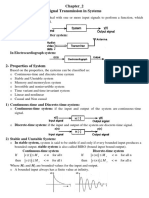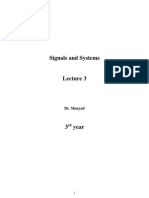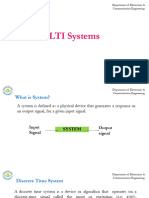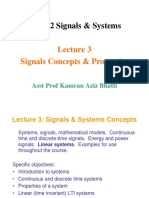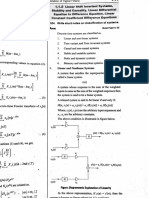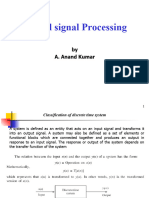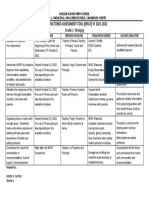Systems
Definition: A system is a set of elements or functional blocks which
are connected together and produces an output in response to an input
signal. The response or output of the system depends on the transfer
function of the system. Mathematically, the input & output are related
by: y(t) = h(t)*x(t). Examples of systems are: filters, amplifiers,
communication channels, T.V set, sound amplifiers, video amplifiers,
etc.
Input x(t) LTI y(t) output (step response)
System h(t) y(t) = h(t)*x(t)
Types of systems: Like signals, systems are also of two types. (1)
continuous-time systems and (2) discrete-time systems.
� Classification of Systems
1. Causal & Non-causal systems: A system is said to be causal if the response or output of
the system at any time [i.e. y(n)] does not depend on future values of the input [i.e.
x(n+1), x(n+2),..] but depends only on the present or past values of the input [i.e. x(n),
x(n-1), x(n-2), …]. Mathematically, the output of a causal system satisfies an equation
of the form: y(n) = F[x(n), x(n-1), x(n-2), …] ………………(i), where F is some
arbitrary function. A causal system is non-anticipatory, (i.e. a system that does not
anticipate its input). Thus, causal systems are physically realizable. On the other hand,
a non-causal system is one whose output or response to an input depends on the future
values of that input. Such a system has an output that depends not only on present and
past inputs but also on future inputs. It is a system that is anticipatory, and cannot be
implemented practically. This means that there’s no system possible practically, which
can produce its output before input is applied. However, if the signal is recorded so that
the processing is done off-line (non-real time), it is possible to implement a non-causal
system, since all values of the signal are available at the time of processing. Thus, some
non-real time systems are non-causal. E.g. image processing systems & processing of
geophysical signals.
Thus, a system defined by the eqn. y(n)=x(n) – x(n+1) is a non-causal system, since the
output y(n) depends on the input at future values, x(n+1)
� Classification of Systems
Example1: Determine whether the following systems are causal or non-
causal: (i) y(n) = x(n) – x(n-1) (ii) y(n) = ax(n) (iii) y(n) = x(n2 )
(iv) y(n) = x(n) + 3x(n+4) (v) y(t) = 0.2x(t) – x(t-1) (vi) y(n) = x(n-1)
(vii) y(t) = x(t+1) (viii) y(n) = x(n) – x(n+1) (ix) y(n-2) = x(n)
Example 2: Determine if the systems described by the following input-
output equations are causal or non-causal:
dy(t)
(i) y(t) = x(-t) (ii) + 10y t + 5 = x(t) (iii) y(t) = x(t)cos(t+1)
d𝑡
(iv) y(t) = x(2t)
� Classification of Systems
2. Time-invariant & Time-variant systems: A system is time-invariant if
the input-output relationship does not vary with time. For a time-
invariant system, the time shift in the input signal results in a
corresponding time shift in the output. Mathematically,
x(n) y(n) and x(n-k) y(n-k) …………….(ii).
A system which does not satisfy eqn. (ii) above is known as a time-
variant system. Thus, a time-variant system is one whose input-output
characteristics change with time. An example is a “differentiator”
represented by the eqn: y(n) = x(n) – x(n-1), “Time multiplier”
represented by y(n) = nx(n), “Folder” y(n) = x(-n), “Modulator” y(n) =
x(n)cos(ω0 n), etc.
� Classification of Systems
Example 3: Check whether the following systems are time-invariant or time-variant: (i) y(n) = sinxn
(ii) y(n) = nx(n) (iii) y(n) = x(-n)
(iv) y(t) = x(t)cos(200π𝑡) (v) y(n) = x(n) – x(n-1)
3. Linear & Non-linear systems: A linear system is one that satisfies the superposition principle. This
means that a linear system is defined as one whose response to the sum of the weighted inputs is the same
as the sum of the weighted outputs. That is,
a1 x1 n + a2 x2 n → a1 y1 n + a2 y2 (n)………………(iii)
For any Non-linear system, the principle of superposition does not hold true and eqn. (iii) is not satisfied.
Examples of linear systems are: filters, communication channels, etc.
At this point, we note that systems satisfying both linearity & time-invariant properties are popularly
known as linear time-invariant systems or simply LTI systems.
Example 4: Check whether the following systems are linear or non-linear:
(i) y(t) = tx(t) (ii) y(t) = x 2 (t) (iii) y(n) = x(n2 )
Question: Given a system whose input-output relation is given by the linear equation: y(t) = ax(t) + b,
where x(t) and y(t) are the input and output of the system respectively, and a and b re constants. Determine
if this system is linear or non-linear.
� Classification of Systems
4. Static & Dynamic systems: A static system is also known as a memoryless
system. Basically, static systems contain no energy-storage elements. A static or
memoryless system is a system whose output signal depends only upon the present
value of the input signal.
E.g. y(n) = x 2 (n), y(n) = x1 (n)x2 (n), y(n) = x1 (n)+ x2 (n), etc.
The systems above are memoryless because the value of the output signal y(n) at a
time n depends only on the present value of the input signal x(n). Another simple
memoryless (static) system is the identity system whose both output & input are
equal. That is y(n) = x(n). A memoryless system contains no derivatives, integrals or
signal delays.
On the other hand, a dynamic system or a system with memory is one whose output
signal depends on both future and past values of the input signal. The systems have
one or more energy elements. E.g. capacitor, accumulator, etc.
A unit delay element is also an example of dynamic system & its input-output
relationship is expressed as y(n) = x(n-1). Another e.g. is a unit advance element:
y(n) = x(n+1).
� Classification of Systems
Miscellaneous Examples
Example 1: Consider a continuous-time system whose input-output
relationship is given by: y(t) = sin[x(t+2)]. Determine if the system is:
(i) memoryless (ii) causal (iii) linear (iv) time-invariant (v) stable.
Example 2: Consider a discrete-time system with input x(n) and output y(n)
related by: y(n) = x(n).x(n-2). Determine whether the system is:
(i) memoryless (ii) causal (iii) linear (iv) time-invariant (v) stable.
Question 1: Consider a continuous-time system with input-output
relationship given as: y(t) = x(t)cos[x(t+3)]. Determine whether the system is:
(i) memoryless (ii) causal (iii) linear (iv) time-invariant (v) stable
Question 2: Consider the input-output relationship of a continuous-time
system given as: y(t) = x(t)cos(3t). Check for the following properties of the
system: (i) memoryless (ii) causality (iii) linearity (iv) time-invariant and
(v) stability.
� Block Diagram Representation of
Discrete-time Systems
Some Important Building Blocks:
An adder: This performs the addition of two signal sequences to form another
sequence denoted by y(n). x (n) 1
A constant multiplier y n = x1 n + x2 (n)
Addition operation is memoryless
x(n) a y n = ax(n) x2 (n)
This is also memoryless
A signal multiplier: This multiplies two signals to form another sequence, denoted
by y(n). x1 n
y n = x1 n . x2 (n)
Multiplication is also memoryless
x2 n
� Block Diagram Representation of
Discrete-time Systems
A unit delay element: This is a special system that simply delays the
signal passing through it by one sample. If the input signal is x(n), the
output is x(n-1). The symbol z −1 will be used to denote the unit of
delay. x n z −1 y n = x n−1
This operation is with memory
A unit advance element: This moves the input x(n) ahead by one
sample in time to yield x(n+1). The operator z will be used.
x n z y n = x n+1
This operation is with memory
� Block Diagram Representation of
Discrete-time Systems
Example 1: Using the basic building blocks, sketch the block diagram
representation of the discrete-time system described by the input-output
relation: y(n) = ¼ y(n-1) + ½ x(n) + ½ x(n-1), where x(n) is the input
and y(n) is the output of the system.
Example 2: Using the basic building blocks, sketch the block diagram
representation of the discrete-time system described by the input-output
2
relation: y(n) – y n + 3 = 3x n + 4x(n − 1)
3
Question: Using the basic building blocks, sketch the block diagram
representation of the discrete-time system described by the input-output
1 1
relation: y(n)− y n + 1 + y n − 2 = 3x n + 2x(n − 1)
5 4
� Thank You for Coming
Did you enjoy the lecture?
Any Feedback?
N/B:
Please visit the e-learning portal regularly for all
assignments.
Submission is via the e-portal.





